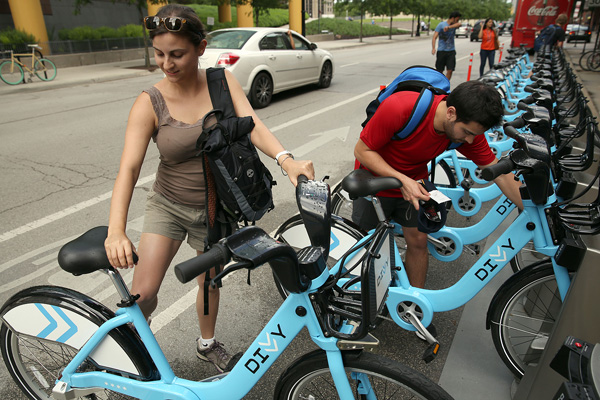
Photo: Terrence Antonio James/Chicago Tribune
Not everyone's experience with Chicago's new bike-sharing program was as smooth as mine; Jon Hilkevitch found that "the shared experience some customers came away with was frustration." For instance:
Alisa Holman was on a CTA bus in the West Loop Friday when the bus driver announced that the route was ending at Harrison and State streets due to the Hawks parade. Holman remembered that she was given a free Divvy daily pass the night before at Daley Plaza, so she picked up a Divvy bike and rode it to the bike station at Fairbanks Street and Grand Avenue.
But the station was full of bikes.
She and two other Divvy customers then rode to the next nearest Divvy station, at Illinois Street and McClurg Court, but the docks at that station were also all occupied by bikes.
By then, Holman was late to an appointment with an attorney.
This is one of the built-in issues with bike-share; it requires "re-balancing," i.e. schlepping bikes from full to empty stations. Think of it as the biking equivalent of bus bunching. (Perhaps riders of, say, the 66 bus could be queried about shared frustration. I'm happy to rant at length about it.) Chicago is fortunate in its lack of topography, suggesting less dockblocking at the bottom of inclines, or similar problems in D.C.:
I don’t use it as much as I’d like to, for one critical reason. I live on top of a hill. Riders are happy to take bikes from the neighborhood to their jobs downhill, but are much less likely to ride them uphill. As a result, the bike racks in my neighborhood are frequently completely empty by 8:00 or 8:30am, despite the many stores and businesses in the area.
Divvy's going to have to tease out the causes of re-balancing; Capital Bikeshare in D.C., as you might expect, relies on historical data when stocking its stations.
So how'd it go, other than the fact that it was "less than smooth for riders who encountered hassles"? It was pretty typical for a bike-share launch:
Of the 4,123 bike trips made from Friday morning to Sunday night, 3,225 were made by annual members, and 898 were from customers who purchased 24-Hour Passes.
This week, the newly launched system will total 75 neighborhood stations and 750 bikes on the street. Divvy will quickly build to 300 stations and 3,000 bikes by the end of August, and 400 neighborhood locations by next spring.
When New York launched its bikeshare program in May, it had 20,551 trips in its first three days of existence. But it also launched with 6,000 bikes at 330 stations, for about 3.5 trips per bike. It took D.C. ten days to reach 4,000 trips, but it only launched with 400 bikes. So New York averaged 1.14 trips per bike per day; D.C, 1.05; and Chicago, about 5.5 trips per bike, or 1.8 trips per bike per day. Does that mean Chicago's is immediately more successful? Not necessarily. Chicago currently has about 1,700 annual members, and New York started with a proportionally higher number of users, some 21,000; D.C. started with a similar number of users, but fewer bikes and fewer stations.
1,700 might not sound like much, but it's a mere four days old. The D.C. program's real growth didn't start until seven months into the program: from a mere 6,000 annual subscribers in March 2011 to 35,000 now. In New York, despite "hitting snags" which are as bad or worse than Chicago's, has added another 15,000 annual members. This weekend saw some problems, but the real test is yet to come.


